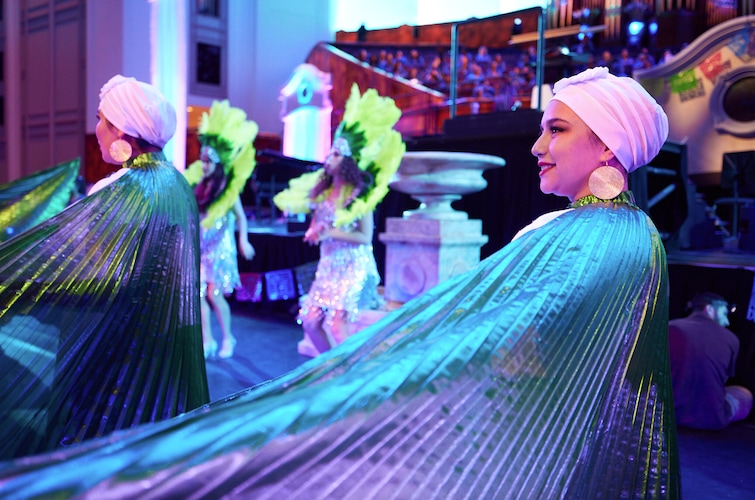Para leer este artículo en español, haz clic aquí.
Carolina Rubio is taking time off from her day job, in real estate, to sing in front of thousands next weekend.
Rubio is one of a thousand volunteer performers — singers, musicians and dancers — taking part in “Luz de las Naciones (Light of the Nations),” a colorful, multilingual celebration of Latin American culture that The Church of Jesus Christ of Latter-day Saints has been throwing since 2002.
This year’s show is scheduled for Friday and Saturday, Nov. 3 and 4, at 8 each night, in downtown Salt Lake City’s Conference Center.
All 35,000 tickets for the show were snapped up five minutes after they were made available in mid-October. People can watch the Saturday performance live from home, via the church’s website and YouTube channel.
Rubio is slated to open the show, singing Gloria Estefan’s song “Mi Tierra (My Land).” The 35-year-old said the song and its theme deeply resonate with her — because she spent the first 10 years of her life living in California and Mexico, before moving to Utah.

(Hunter McCall Winterton | Courtesy of The Church of Jesus Christ of Latter-day Saints) Dancers prepare at the dress rehearsal on Oct. 27, 2023, for "Luz de las Naciones," a celebration of Latino heritage put on by The Church of Jesus Christ of Latter-day Saints. Performances are set for Nov. 3 and 4, 2023.
“I identify with it because I miss the land where I grew up,” Rubio said, in Spanish, at Friday’s dress rehearsal. “I grew up in Mexico, I have those roots very attached to me. So when I listen to Mexican music I get excited, I get goose bumps.”
Rubio also said she feels proud to be part of the show, because events like these highlight how Hispanics keep making history and becoming pioneers.
The show’s theme this year is “Nuestra Tierra (Our Land),” and organizers say it is an homage to the land that many have left behind to move to Utah — and a representation of how migrants have adapted to their new home and set a foundation for future generations.
“This year we’re celebrating 100 years that the first Latino settlers came to this valley,” Israel González-Nieri, director of “Luz de las Naciones,” said at the dress rehearsal. “We’re going to talk about the stories of those people and how, because of their examples, now we have this big community here in Utah.”
(Hunter McCall Winterton | Courtesy of The Church of Jesus Christ of Latter-day Saints) Dancers prepare at the dress rehearsal on Oct. 27, 2023, for "Luz de las Naciones," a celebration of Latino heritage put on by The Church of Jesus Christ of Latter-day Saints. Performances are set for Nov. 3 and 4, 2023.
Thousands of people audition for a spot among the choir, orchestra, dancers and narrators who perform the show. About half those performing, González-Nieri said, are immigrants — and, for some Utah families, being in the show has become a multigenerational tradition.
“A lot of them have probably two jobs, if not more, and they’re all volunteers, so they make huge sacrifices,” Gonzalez-Nieri said. “So through music and dance, we’re going to talk about … some of those struggles that sometimes you have to go through when you come to a new land.”
The show will feature performances from such countries as Panama, Cuba, Colombia, Argentina, Peru, Brazil, Spain and Equatorial Guinea.
(Hunter McCall Winterton | Courtesy of The Church of Jesus Christ of Latter-day Saints) Dancers prepare at the dress rehearsal on Oct. 27, 2023, for "Luz de las Naciones," a celebration of Latino heritage put on by The Church of Jesus Christ of Latter-day Saints. Performances are set for Nov. 3 and 4, 2023.
For one of the numbers, a six-member band joins the choir to play “Valicha,” a Peruvian-Quechua song. Dozens of dancers perform in traditional red, black and white attire with green and pink details, alpaca ponchos, ear covers, hats, rubber sandals and braided furry ropes.
For a performance representing Brazil, a soloist sings in Portuguese while dancers — wearing sparkly costumes with vibrant colors and feathers — incorporate samba dance moves into their routine.
Throughout the show, there are colorful costumes and audiovisual elements, said Federico Kahnlein, the event’s chair.
Kahnlein, speaking in Spanish, said “this is going to be a unique event” because of the visual elements “but also because of history. … We are going to commemorate the first Latino pioneers who came to Utah Valley and established the first Latino congregation 100 years ago.”
(Hunter McCall Winterton | Courtesy of The Church of Jesus Christ of Latter-day Saints) The organ at the Conference Center at Temple Square serves as the backdrop for the dress rehearsal on Oct. 27, 2023, for "Luz de las Naciones," a celebration of Latino heritage put on by The Church of Jesus Christ of Latter-day Saints. Performances are set for Nov. 3 and 4, 2023.
Alixel Cabrera is a Report for America corps member and writes about the status of communities on the west side of the Salt Lake Valley for The Salt Lake Tribune. Your donation to match our RFA grant helps keep her writing stories like this one; please consider making a tax-deductible gift of any amount today by clicking here.







